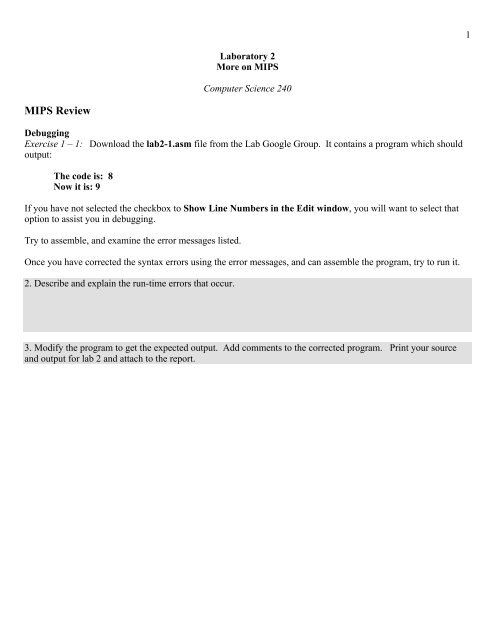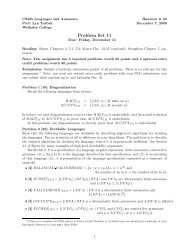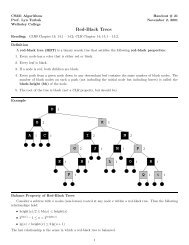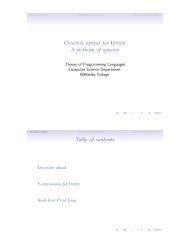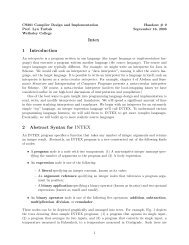Lab 2 exercises - Computer Science
Lab 2 exercises - Computer Science
Lab 2 exercises - Computer Science
Create successful ePaper yourself
Turn your PDF publications into a flip-book with our unique Google optimized e-Paper software.
MIPS Review<br />
<strong>Lab</strong>oratory 2<br />
More on MIPS<br />
<strong>Computer</strong> <strong>Science</strong> 240<br />
Debugging<br />
Exercise 1 – 1: Download the lab2-1.asm file from the <strong>Lab</strong> Google Group. It contains a program which should<br />
output:<br />
The code is: 8<br />
Now it is: 9<br />
If you have not selected the checkbox to Show Line Numbers in the Edit window, you will want to select that<br />
option to assist you in debugging.<br />
Try to assemble, and examine the error messages listed.<br />
Once you have corrected the syntax errors using the error messages, and can assemble the program, try to run it.<br />
2. Describe and explain the run-time errors that occur.<br />
3. Modify the program to get the expected output. Add comments to the corrected program. Print your source<br />
and output for lab 2 and attach to the report.<br />
1
Storage allocation and program execution<br />
Exercise 2 - 1. Predict the address and data contents of the following data segment from lecture .<br />
.data<br />
str: .byte 1,2,3,4<br />
.half 5,6,7,8<br />
.word 9,10,11,12<br />
.space 5<br />
.word 9,10,11,12<br />
letters: .asciiz “ABCD”<br />
.ascii “ABCD”<br />
.byte -1<br />
• Use little-endian byte order<br />
• Show one word (4 bytes) per row.<br />
• Lowest address (0x10010000) should be at<br />
bottom of stack.<br />
• <strong>Lab</strong>el the addresses corresponding to str and<br />
letters<br />
• Use hexadecimal notation<br />
Address <strong>Lab</strong>el<br />
0x10010000<br />
2. Predict how the values of $a0 and $t0 change as each instruction is executed, and answer the stated questions:<br />
main: li $v0,11<br />
li $t0,2<br />
lb $a0,letters($t0)<br />
syscall<br />
What is the result of the syscall?<br />
addi $a0,$a0,-1<br />
syscall<br />
What is the result of the syscall?<br />
addi $t0,$t0,1<br />
lb $a0,letters($t0)<br />
syscall<br />
What is the result of the syscall?<br />
li $t0,’Z’<br />
sb $t0,letters<br />
lb $a0,letters<br />
syscall<br />
$t0 $a0<br />
0x00000000 0x00000000<br />
Data<br />
What is the result of the syscall?<br />
Update the memory diagram above to show what happens after the sb $t0,letters is executed.<br />
li $v0,10<br />
syscall<br />
3. Download lab2-2.asm from the <strong>Lab</strong> Google Group and single-step the program to verify your results.<br />
Examine the Data Segment to check that your storage allocation diagram is correct.<br />
2
Exercise 3: Write a MIPS program which does the same thing as the following Java statements.<br />
//initialize only these two strings in memory<br />
String phrase = “Change: inevitable”;<br />
String addon = “ except from vending machines”;<br />
//should output the string ‘Change: inevitable’<br />
System.out.println(phrase);<br />
//should output ‘Change: inevitable except from vending machines’ with a single syscall<br />
phrase = phrase.concat(addon);<br />
System.out.println(phrase);<br />
//should output ‘Charge!’<br />
phrase = phrase.replace(‘:’,’!’);<br />
phrase = phrase.substring(0,7)<br />
phrase = phrase.replace(‘n’,’r’);<br />
System.out.println(phrase);<br />
Print your source and output for exercise 3 and attach to the lab report.<br />
3
Numeric representation<br />
Exercise 4: On paper, perform addition on the following binary and hexadecimal numbers (assume two’s<br />
complement format!). Indicate whether there is a carry-out or an overflow for each addition.<br />
Hex Binary Hex Binary<br />
0 0000 8 1000<br />
1 0001 9 1001<br />
2 0010 A 1010<br />
3 0011 B 1011<br />
4 0100 C 1100<br />
5 0101 D 1101<br />
6 0110 E 1110<br />
7 0111 F 1111<br />
1. For the first 2 calculations, assume 16- bit representation. Do the calculation using the binary values.<br />
Then, convert the numbers for the operands and result to hexadecimal notation (to convert, divide the digits into<br />
groups of 4, and translate each group to the corresponding hexadecimal value).<br />
1 1 1 1 1 1 1 1 1 1 1 1 1 1 1 1<br />
+ 1 1 1 1 1 1 1 1 1 1 1 1 1 1 1 1<br />
0 1 1 1 1 1 1 1 1 0 0 0 0 0 0 0<br />
+ 0 1 1 1 1 1 1 1 1 0 0 1 1 0 0 1<br />
Carry-Out? Overflow?_ Hexadecimal Value<br />
2. Now, assume 32-bit representation. The numbers are given are in hexadecimal notion.<br />
0x A A F F 9 0 1 4<br />
+ 0x A A E 3 C D 1 2<br />
0x 7 F A A 3 2 7 8<br />
+ 0x 6 0 2 4 C D 1 2<br />
Carry-Out? Overflow?_<br />
4
3. Use MARS to write a very simple program that adds the contents of $t0 and $t1, and puts the result in $t2:<br />
.text<br />
.globl main<br />
main: add $t2,$t0,$t1 # add contents of $t0 and $t1, and store result in $t2<br />
li $v0,10 # terminate execution<br />
syscall<br />
After assembling the program (but before executing), enter the values for $t0 and $t1 directly into the Registers<br />
panel. Use the 32-bit hexadecimal values from the previous exercise:<br />
0x A A F F 9 0 1 4<br />
+ 0x A A E 3 C D 1 2<br />
Verify that your result from the calculation was correct by observing the result in $t2 from the Registers panel<br />
after executing the program.<br />
4. Now, reset the program, but this time enter the second set of 32-bit values from the previous exercise before<br />
running the program:<br />
0x 7 F A A 3 2 7 8<br />
+ 0x 6 0 2 4 C D 1 2<br />
Execute the program. Describe what happens:<br />
5
More on System Calls<br />
Print hardcopies of the following programs that you complete, and attach them to your lab report.<br />
Also save copies for future reference (on a flash drive or server and/or email them to yourself and your partner ).<br />
Reading from a file<br />
Exercise 5: You have seen how to read a string or an integer from the keyboard using a system call. You can also<br />
read characters from a file, using system calls for opening, reading from, and closing a file (in MARS, read more<br />
about these from the Help menu Syscalls tab).<br />
1. Download the program test.asm and lab2-3.asm from the <strong>Lab</strong> Google Group. The test.asm file contains<br />
characters which will be read by the MIPS program in lab2-3.asm.<br />
2. Put test.asm and lab2-3.asm files in the same place as the Mars.jar executable file. One easy way to do this is<br />
to download Mars.jar to the desktop, and then keep your files on the desktop, as well.<br />
3. Open lab2-3.asm in MARS; it contains a code skeleton which opens a file for reading, and then closes it.<br />
Study the code in the main program listed below to make sure you understand its purpose:<br />
.data<br />
filename: .space 32<br />
fnlength: .word 9<br />
prompt1: .asciiz "Enter a filename: "<br />
.text<br />
li $v0,4 #prompt user for filename<br />
la $a0,prompt1<br />
syscall<br />
li $v0,8 #read in filename string &<br />
la $a0,filename #store in memory<br />
lw $a1,fnlength<br />
syscall<br />
li $v0, 13 #open file<br />
la $a0,filename #$a0 = addr of filename string<br />
li $a1,0 #set mode to read<br />
li $a2,0<br />
syscall<br />
move $s6,$v0 #save file descriptor in $s6<br />
#put code here to read a character from the file<br />
#put code here to print the character to the console<br />
close_file: li $v0, 16 #close the file<br />
move $a0,$s6<br />
syscall<br />
donemain: li $v0,10 #exit<br />
syscall<br />
6
4. To add the code to read a character from the file, follow the syscall contract for reading from a file.<br />
HINT: you will need to define a location in memory (input_buffer) to hold the character, similar<br />
to what you do to read a string from the keyboard.<br />
syscall contract for reading from a file<br />
$v0 arguments result<br />
14<br />
$a0 = file descriptor<br />
$a1 = address of input_buffer<br />
$a2 = maximum number of characters to<br />
read<br />
- input buffer contains character read in<br />
- $v0 contains number of characters read (0 if end-of-file, -1<br />
if error)<br />
5. After you read in a character, store the character in $t1 and print it to the console using the print character<br />
system call (service code 11).<br />
The first character in test.asm is ‘#’, so that is the character you should see printed.<br />
At that point, you could continue to read the rest of the characters from the file by repeating the code to print in<br />
a character (such as with a loop, as we will learn about next week in lecture).<br />
How do you think you will know when you have read in all the characters from the file?<br />
6. Add code which checks whether the character read in is alphabetic (upper or lowercase). Use the following<br />
contract:<br />
• Assume the character to be tested is still in $t1 after reading it in from the file.<br />
• After testing $t1, set $s3 = 1 if the character is alphabetic, and 0 otherwise.<br />
Test by running the program, and examining the value of $s3 after execution. Modify the test.asm file several<br />
times, changing the first character to various values, and running the program each time to determine if your test<br />
works correctly for a variety of characters.<br />
Printing hex, binary, or unsigned integer values<br />
Exercise 6: Write a MIPS program that prompts for an integer number, and then displays the hexadecimal,<br />
binary, and unsigned versions of the number (look up system calls 34 – 36). You may find this helpful for<br />
checking your work when you are doing numeric representation <strong>exercises</strong>.<br />
Generating audible tones (making music)<br />
Exercise 7: Write a MIPS program that plays a song! Experiment with system call 33. Be creative!<br />
7


